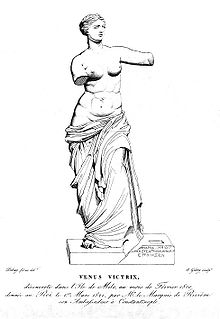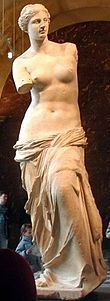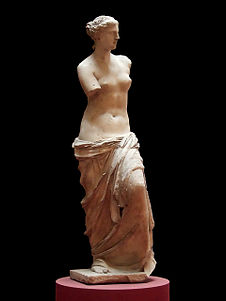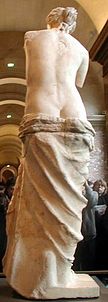- Venus de Milo
-
Venus de Milo 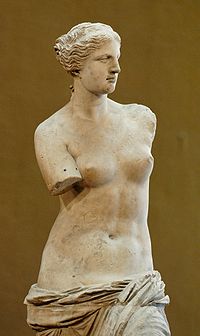
Artist Alexandros of Antioch Year Between 130 and 100 BC Type Marble Location Louvre Museum, Milos  Marcus Aurelius (head covered)
Marcus Aurelius (head covered)
sacrificing at the Temple of JupiterPractices and beliefsImperial cult · festivals · ludi
mystery religions · funerals
temples · auspice · sacrifice
votum · libation · lectisterniumPriesthoodsCollege of Pontiffs · Augur
Vestal Virgins · Flamen · Fetial
Epulones · Arval Brethren
Quindecimviri sacris faciundisJupiter · Juno · Neptune · Minerva
Mars · Venus · Apollo · Diana
Vulcan · Vesta · Mercury · CeresOther deitiesJanus · Quirinus · Saturn ·
Hercules · Faunus · Priapus
Liber · Bona Dea · Ops
Chthonic deities: Proserpina ·
Dis Pater · Orcus · Di Manes
Domestic and local deities:
Lares · Di Penates · Genius
Hellenistic deities: Sol Invictus · Magna Mater · Isis · Mithras
Deified emperors:
Divus Julius · Divus Augustus
See also List of Roman deitiesRelated topicsRoman mythology
Glossary of ancient Roman religion
Religion in ancient Greece
Etruscan religion
Gallo-Roman religion
Decline of Hellenistic polytheism
Aphrodite of Milos (Greek: Ἀφροδίτη τῆς Μήλου, Aphroditē tēs Mēlou), better known as the Venus de Milo, is an ancient Greek statue and one of the most famous works of ancient Greek sculpture. Created at some time between 130 and 100 BC, it is believed to depict Aphrodite (Venus to the Romans) the Greek goddess of love and beauty. It is a marble sculpture, slightly larger than life size at 203 cm (6 ft 8 in) high. Its arms and original plinth have been lost. From an inscription that was on its plinth, it is thought to be the work of Alexandros of Antioch; it was earlier mistakenly attributed to the master sculptor Praxiteles. It is currently on permanent display at the Louvre Museum in Paris.
Contents
Description
Although the Aphrodite of Milos is widely renowned for the mystery of her missing arms[1] enough evidence remains to prove that the right arm of the goddess was lowered across the torso with the right hand resting on the raised left knee so the sliding drapery wrapped around the hips and legs could be held in place.[citation needed] There is a filled hole below the right breast that originally contained a metal tenon that would have supported the separately carved right arm.
The left arm was held at just below the eye level of the statue above a herm while holding an apple. The right side of the statue is more carefully worked and finished than the left side or back, indicating that the statue was intended to be seen mainly as a profile from its right. The left hand would have held the apple up into the air further back inside the niche the statue was set in. When the left hand was still attached, it would have been clear to an observer that the goddess was looking at the apple she held up in her left hand.
The statue would have been tinted as was the custom of the era, adorned with jewelery and positioned in a niche inside a gymnasium. The painting of the statue along with the bedecking in jewelery were intended to make it appear more lifelike. Today, all traces of any paint have disappeared and the only signs of the armbands, necklace, earrings and crown are the attachment holes.
The twisting stance and strong projection of the knee, as well as the rich, three-dimensional quality of the drapery, are typical of Hellenistic art of the third century BC and later. Moreover, the sensuous juxtaposition of flesh with the texture of drapery, which seems about to slip off the figure, adds an insistent note of erotic tension that is thoroughly Hellenistic in concept and intent.
Discovery and history
The Aphrodite of Milos was discovered by a peasant named Yorgos Kentrotas on April 8, 1820, inside a buried niche within the ancient city ruins of Milos, the current village of Tripiti, on the Aegean island of Milos (also Melos, or Milo).[2] The statue was found in two main pieces (the upper torso and the lower draped legs) along with several herms (pillars topped with heads), fragments of the upper left arm and left hand holding an apple, and an inscribed plinth. Olivier Voutier, a French naval officer, was exploring the island. With the help of the young farmer, Voutier began to dig around what were clearly ancient ruins. Within a few hours Voutier had uncovered Venus de Milo. About ten days later, another French naval officer, Jules Dumont d'Urville, recognized its significance and arranged for a purchase by the French ambassador to Turkey, Charles-François de Riffardeau, marquis, later duc de Rivière.
Twelve days out of Touloun the ship was anchored off the island of Melos. Ashore, d'Urville and [fellow officer] Matterer met a Greek farmer Moraitis, who a few days earlier while ploughing his fields had uncovered blocks of marble and a statue in two pieces, which he offered cheaply to the two young men. It was of a naked woman with an apple in her raised left hand, the right hand holding a draped sash falling from hips to feet, both hands damaged and separated from the body. Even with a broken nose, the face was beautiful. D'Urville the classicist recognized the Venus of the Judgement of Paris. It was, of course, the Venus de Milo. He was eager to acquire it, but his practical captain, apparently uninterested in antiquities, said there was nowhere to store it on the ship, so the transaction lapsed. The tenacious d'Urville on arrival at Constantinople showed the sketches he had made to the French ambassador, the Marquis de Rivière, who sent his secretary in a French Navy vessel to buy it for France. Before he could take delivery, French sailors had to fight Greek brigands for possession. In the mêlée the statue was roughly dragged across rocks to the ship, breaking off both arms, and the sailors refused to go back to search for them.[3]
This story however proved to be a fabrication - Voutier's drawings of the statue when it was first discovered show that its arms were already missing (Curtis, 2003).
News of the discovery took longer than normal to get to the French ambassador. The peasant grew tired of waiting for payment and was pressured into selling it to Nicholas Mourousi, Grand Dragoman of the Fleet, working as a translator for Sultan Mahmud II in Constantinople (present day Istanbul, Turkey).
The French ambassador's representative, Vicomte de Marcellus, arrived just as the statue was being loaded aboard a ship bound for Constantinople and seized the statue and persuaded the island's chief citizens to annul the sale.
Upon learning of the reversal of the sale, Nicholas Mourousi presumably had the chiefs whipped and fined. In 1821, Mourousi was executed by order of Sultan Mahmud II in front of the arsenal in Constantinople. This was amidst massive executions of Phanariote Greeks and the beginning of the Greek War of Independence.[4]
Upon arrival at the Louvre, the statue was reassembled, but the fragments of the left hand and arm were initially dismissed as being a later restoration because of the rougher workmanship.[citation needed] It is now accepted that the left hand holding the apple and the left arm are in fact original to the statue but were not as well finished as the rest of the statue since they would have been somewhat above eye level and difficult to see.[citation needed] This was a standard practice for many sculptors of the era—less visible parts of statues were often not as well finished since they would typically be invisible to the casual observer.[citation needed] Sculptures and statues from this era were normally carved out of several blocks of stone and carefully pieced together.[citation needed] The Venus de Milo turns out to have been carved from at least six to seven blocks of Parian marble: one block for the nude torso, another block for the draped legs, another block apiece for each arm, another small block for the left foot, another block for the inscribed plinth and finally the separately carved herm that stood beside the goddess.
The controversial plinth was initially found to fit perfectly as part of the statue, but after it was translated and dated, the embarrassed experts who had publicized the statue as a possible original work by the artist Praxiteles dismissed it as another later addition to the statue. The inscription read: "...(Alex)andros son of Menides, citizen of Antioch on the Maeander made this (statue)...". The inscribed plinth would have moved the dating of the statue from the Classical period to the Hellenistic period because of the style of lettering and the mention of the ancient city of Antioch on the Maeander, which did not exist in the early fourth century BC, when Praxiteles lived. The Hellenistic Age was at that time considered a period of decline for Greek art. The plinth mysteriously disappeared shortly before the statue was presented to King Louis XVIII in 1821 and only survives in two drawings and an early description. The king eventually presented the statue to the Louvre museum in Paris.
In 1920, sculptor Robert Ingersoll Aitken created a stir when he criticized the display, lighting and placement of the statue of Venus de Milo.[5]
In the autumn of 1939, the Venus was packed for removal from the Louvre in anticipation of the outbreak of war. Scenery trucks from the Comédie-Française transported the masterpieces of the Louvre to safer locations in the countryside.[6] During the years of World War II, the statue sheltered in safety in the Château de Valençay along with the Winged Victory of Samothrace and Michelangelo's Slaves.[7]
Fame
The Aphrodite of Milos's great fame in the 19th century was not simply the result of its admitted beauty, but also owed much to a major propaganda effort by the French authorities. In 1815, France had returned the Medici Venus to the Italians after it had been looted from Italy by Napoleon Bonaparte. The Medici Venus, regarded as one of the finest Classical sculptures in existence, caused the French to consciously promote the Venus de Milo as a greater treasure than that which they had recently lost. It was duly praised by artists and critics as the epitome of graceful female beauty; however, Pierre-Auguste Renoir was among its detractors, labeling it a "big gendarme".
Contemporary Use
The statue used to be on the seal of the American Society of Plastic Surgeons (ASPS), one of the oldest associations of plastic surgeons in the world.[8]
Additionally, an allusion to the statue was made in the film The Dreamers.
See also
- Aphrodite of Knidos
Notes
- ^ G. Davidson, Disarmed: The Story of the Venus de Milo (New York: Alfred A. Knopf) 2003.
- ^ "Venus de Milo (sculpture)". Britannica.com Inc.. Encyclopædia Britannica. http://www.britannica.com/EBchecked/topic/625740/Venus-de-Milo. Retrieved 6 April 2011.
- ^ S.-C. Dumont D'Urville Two Voyages to the South Seas, Memoirs of Captain Jules. Introduction by Helen Rosenmann.
- ^ See Philip Mansel's "Constantinople: City of World's Desire, 1453-1924" (New York: Saint Martin's Press, 1996) p. 243
- ^ "Critisises museum sculpture settings; Robert Aitken says famous venus de Milo in the Louvre is worst placed of all. Stirs federation of arts academician hits at the Metropolitan among home museums and dwells on poor lighting." (pdf). New York Times. May 21, 1920. http://www.query.nytimes.com/gst/abstract.html?res=F20810FF3B5B11728DDDA80A94DD405B808EF1D3. Retrieved January 30, 2011.
- ^ Nicholas 1994, p. 55
- ^ Nicholas 1994, p. 87
- ^ Journals.lww.com
References
- Curtis, Gregory. (2003). Disarmed: The Story of the Venus de Milo. New York: Alfred A. Knopf. 10-ISBN 0-375-41523-8/13-ISBN 978-0-375-41523-4; OCLC 51937203
- Nicholas, Lynn H. (May 1995) [1994]. The Rape of Europa: The Fate of Europe's Treasures in the Third Reich and the Second World War. New York City: Vintage Books. ISBN 978-0-679-40069-1. OCLC 32531154.
External links
Categories:- Venus de Milo
- Antiquities of the Louvre
- Hellenistic sculpture
- Ancient Melos
Wikimedia Foundation. 2010.

